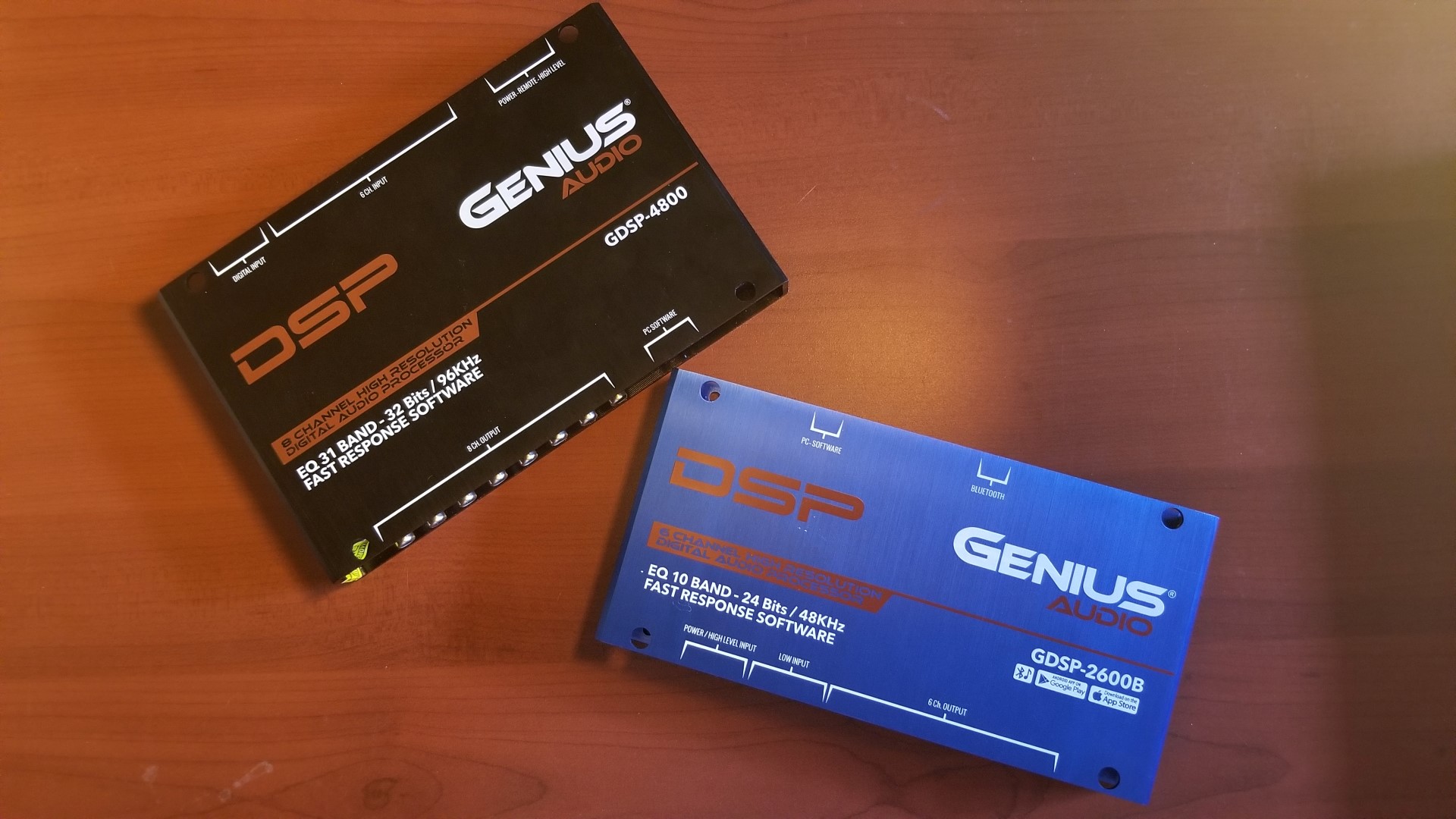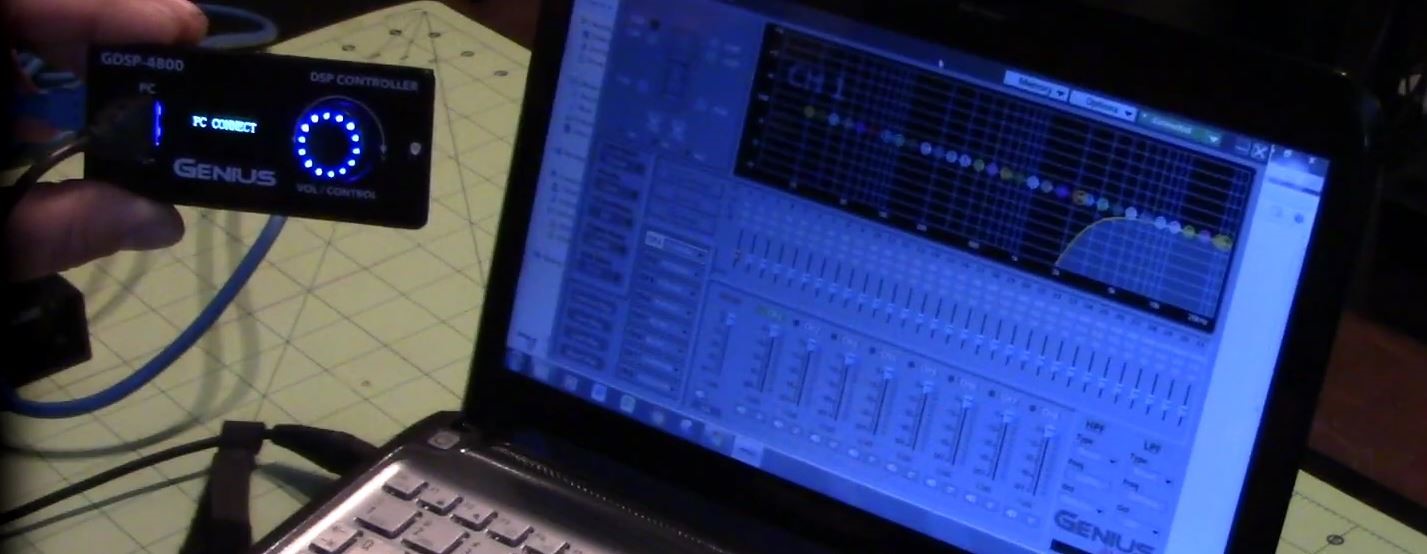
This month I decided to review a couple products that aren’t quite as sexy as amplifiers and subwoofers but is just as important if you want a nice sounding audio system. Those products are Genius Audios DSP units or, Digital Signal Processors as they are technically known, and they serve a very important role in car audio, so much so that you more than likely have a basic one in your system already and don’t even know it. I say that because a lot of head units and even amplifiers have a basic DSP built into them, which is why you can set crossovers, equalizer, and Q factors from your radio. So now the question is, if I already have one in my radio why do I need another one? Well, as I said previously, the one in your radio is basic and if you have a basic system then you don’t need an external DSP and you should stop reading. On the other hand, if your an audiophile or just like to put as many speakers and amps as possible in your car you will benefit greatly from an external DSP by having multiple output channels and the ability to independently set every channel to your liking.
What is a DSP

A DSP takes the analog inputs from your radio in the form of RCA or high level and converts the information to a digital format. While the signals are in the digital format they are then manipulated to the users liking thru equalizers, crossovers, time delay and many other options. Once the signal has been manipulated it is then converted back to analog and fed out thru RCA’s to the systems amplifiers. On top of having the ability to manipulate the signal a DSP also allows you to have multiple channels of output. So for instance, if you have a radio with front and rear RCA outputs on it that limits you to 4 channels of signal. Take those same inputs and run them into a DSP and you can have up to 16 channels of output, depending on the model. The two I will be reviewing in this article are a 6 channel and 8 channel. The number of outputs will allow you to expand your audio system to not only front and rear but you can have front, center, rear, subwoofer, mid bass, etc. The other benefit of a DSP is the signal, since it was converted to digital and then back is now a much higher quality signal which will allow the amplifiers to reproduce the sound much more efficiently and with more headroom before distortion occurs.
What makes DSP’s different
There are two major differences in a DSP which are how the user interacts with the unit and the price. Most DSP use the same circuitry and microchip sets to achieve the filtering and equalization so the only way for companies to differentiate themselves from the other brands is with the user interface and to keep the price point low enough to attract more customers.
Genius DSP basics
So now that we have the explanation out of the way let’s take a look at the Genius Audio DSP units. For an even more detailed review you can see my hands on video of both units on my YouTube channel Custom Audio Reimagined. You will be able to see the user interfaces and how you interact them which is one of the major differences between the two units. The units are the GDSP-2600B and the GDSP-4800. The GDSP-2600B is a six-channel DSP with a Bluetooth and PC interface. The GDSP-4800 is an eight-channel DSP with a PC and dash mount controller interface. Both units have high level and low level inputs while the eight-channel adds digital input capabilities thru digital coaxial or toslink fiber optic. Each of the units come with a CD Rom which you will use to load up the user interface software on your computer. Once the software is running you can plug the units into the computer using a USB cable, which will show a connected icon on the software’s main screen. Once you are connected you can adjust the following for each channel:
- Equalizer (6 channel is 10 band/ 8 channel is 31 band)
- Crossover points (Hi and Lo available on all channels to any frequency)
- Crossover Type (you can choose between a Butterworth, Linkwitz-Riley or Bessel)
- Crossover Slope (6db or 12db on 6 channel/ 6db, 12db, 24db, 48db on 8 channel)
- Time Delay (set to UNIT, MS, CM, or INCHES)
- Value Q (between 0.404-28.82)
- Gain (-12db to +12db)
- Frequency Adjust (from 20 to 20,000Hz at 1/3 octave)
Once you have adjusted the above features to your liking you can save the settings as a preset on the machines and your PC. You then lock it down by sending the preset to the unit and that’s it, the DSP is now set to those settings.
 Genius DSP user interface
Genius DSP user interface
The user interfaces for both units are quite different. The six-channel DSP is what I would consider a basic or beginners DSP and the interface reflects that on the PC and the Bluetooth app. In no way is that a negative reflection of the unit, it just means that the interface is very basic without any colors or graphics to confuse a new customer. It’s very easy to learn how to make adjustments and everything on the PC is on one screen so you never need to tab over to another page. The app which is how you connect to the unit thru Bluetooth is not as easy to understand due to the fact that everything is on separate pages; this is because the size of a cell phone screen not making it possible to view everything on one page. Due to this difference I would personally use the PC interface to do my main adjustments and then use the Bluetooth function to make adjustments from the driver’s seat. Using it in that way makes it a perfect combination.
The eight-channels user interface is much more professional and would be geared towards a professional or someone who knows their way around car audio. The layout is pretty much the same as the six-channel but does not include a Bluetooth option. Comparing the PC interfaces is night and day, literally, the eight-channels interface screen is dark with nice colorful bubbles for each EQ frequency and wireframe speaker outlines for the visual car setup. Making changes is identical to the six-channel but with the eight-channel you get 31 bands of EQ as opposed to the six-channels 10. You also get four levels of crossover slope adjustment compared to the six-channels two. The other major difference is the eight-channel instead of a Bluetooth interface has a dash mount controller that has a very nice and bright screen. From the controller you can adjust master volume, choose an input and bring up presets. This works by using the PC interface and saving presets to the machine. Once saved you can recall and load those presets from the controller allowing you to have fine tuned adjustments for your different music genres.
Why choose a Genius DSP

When it comes to choosing a DSP you have a lot of options from a lot of brands. As I said before the two main differences between DSPs is the user interface and price. After using these units for a couple of days and recording a 34 minute review on YouTube I can say that the interfaces for both units are well suited to the units. They were easy to learn and didn’t cause me any head scratching moments, which is more than I can say for other DSP units I have used. So with the interfaces being satisfactory the next thing to consider is price. Most DSPs on the market will range from $300 to $600 based on brand and features. I have used and currently own a $300 six-channel DSP from a big manufacturer and I compared the features and interface of that unit to the Genius six-channel and the Genius has twice as many available features and its MSRP is only $150. At $150 I could have bought two of them for the same price as the one I have and had twelve channels of output. Based on the features and price the six-channel from Genius is a no brainer for an entry level or factory radio upgraded system.
The eight-channel DSP is, as I said before, much more professional and what I would consider a higher end product. This unit would be great for IASCA competitors and audiophiles alike. Or if you just have a huge system with a lot of amplifiers this is the clean way to get all the signals distributed rather than using RCA Y-splitters. So that being said its probably really expensive right? Nope, the MSRP on the eight-channel is $290 which is cheaper than the six-channel I currently own that has less features. The eight-channel is an easy sell and an easy buy for any shop or customer that wants to have that extra flexibility when controlling their audio system.
Conclusion
After almost 30 years in this industry I am a certified nerd and love any products that allow me to express that. A DSP is one of the ultimate nerd products for an audio guy, but can be intimidating. With the easy to use interfaces and the flexibility of the Genius GDSP-2600B and GDSP-4800 along with the ridiculously affordable price now anybody can be the master of their systems and join the ranks of an audio nerd. I love it when a product works and when it’s affordable and the Genius DSPs cover all those bases and more. You can learn more about Genius audio at www.geniusaudiousa.com.










